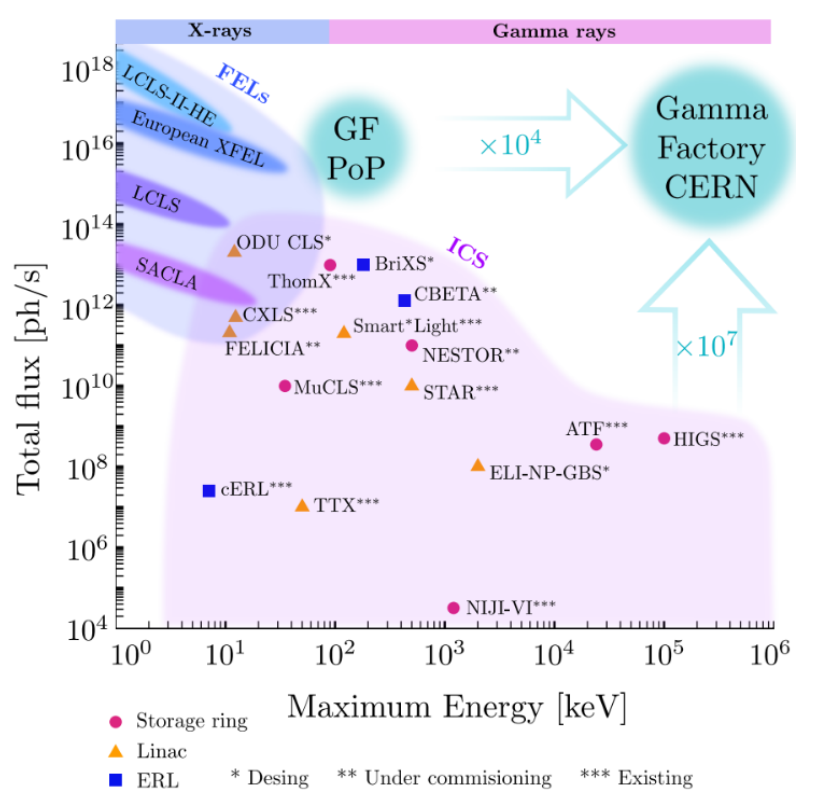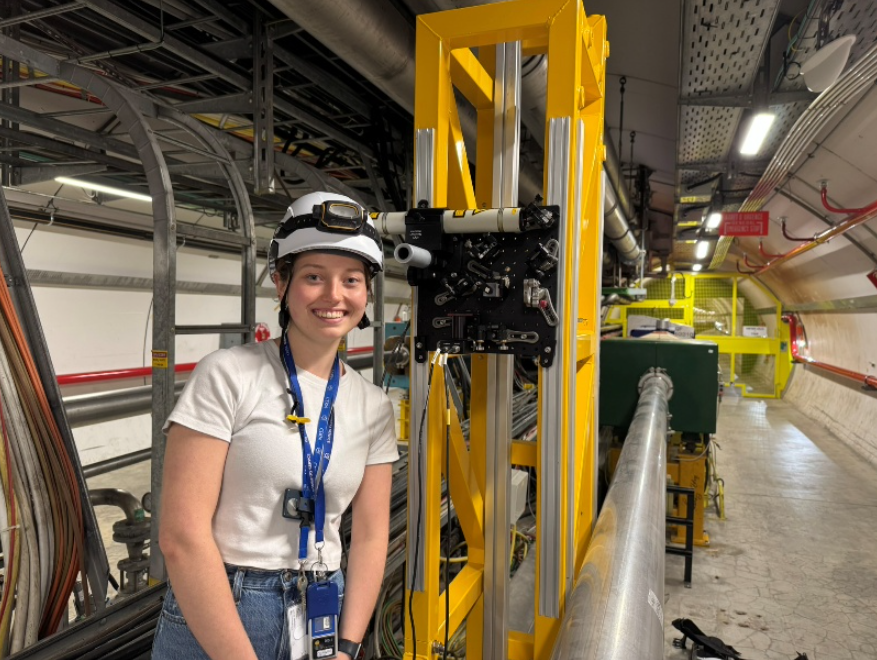‘Good vibes’ from the Gamma Factory
By Eduardo Granados (CERN)
A bold initiative within CERN’s Physics Beyond Colliders (PBC) programme, the Gamma Factory (GF) seeks to unlock a novel research frontier by producing high-energy, high-intensity gamma-ray beams using partially stripped ions (PSIs) and state-of-the-art laser systems. By exploiting existing accelerator infrastructure in unconventional ways, the GF initiative could one day generate photon fluxes exceeding 10¹⁷ photons per second, several orders of magnitude beyond current gamma-ray sources (see comparison in Figure 1).

The main idea of the GF (depicted in Figure 2) is to send ultrafast laser pulses in a counter-propagating geometry to a partially stripped ion beam with a high Lorentz factor γ.
The laser photons are Doppler-boosted by a factor of 2γ in the ions’ rest frame, enabling resonant excitation and subsequent spontaneous emission of secondary photons. These emitted photons receive a second Doppler boost in the lab frame, resulting in a highly tunable, narrowband γ-ray source with energies reaching several hundred MeV. The technique also offers the prospect of fast laser cooling of high-energy hadron beams.

While the long-term vision involves deploying the GF at the LHC, the operational complexity and resource demands make this infeasible in the near term. Instead, the GF team is focusing on a proof-of-principle (PoP) experiment at the Super Proton Synchrotron (SPS), whose results could later be extrapolated to LHC conditions. The SPS-based PoP experiment will utilise a beam of lithium-like lead ions (²⁰⁸Pb⁷⁹⁺) with lifetimes on the order of 100 seconds. A successful stripping scheme to maximise beam intensity has already been demonstrated in collaboration with the SPS operations team. Plans are underway to install the high-power laser system in sector LSS6 of the SPS, with first experiments foreseen around 2028.
The technical requirements on the optical side are daunting: femtosecond pulse durations at 40 MHz repetition rates, with average powers approaching 200 kW. Meeting these demands requires cutting-edge optical engineering. A recent milestone, achieved in collaboration between IJCLab Orsay, demonstrated stable intra-cavity power levels exceeding 500 kW in Fabry–Perot resonators—setting a new benchmark in laser technology (Appl. Phys. Lett. 124, 251105, 2024). This achievement was enabled by combining advanced thin-film coatings developed at the LMA platform of IP2I Lyon with ultra-stable laser oscillators. Such systems also pave the way for compact Compton-based light sources and high-average-power EUV systems for lithography applications.
The experiment will be located in TS65, a straight section of the SPS that benefits from adjacency to the decommissioned TI18 tunnel, a former LEP-era transfer line now slated to house the laser laboratory. The challenge lies in transporting the laser beam over a considerable distance under vacuum, with remote-controlled steering, mode matching, and active stabilization to ensure efficient coupling to the optical cavity in the SPS ring. Integration for this system have been developed by F. Galleazzi and collaborators (EN-ACE-INT).

One of the major concerns in this setup is vibrational stability. To this end, the SPS tunnel’s vibration environment was characterised during the SPS heat run in March 2023 [https://cds.cern.ch/record/2868829]. Insights from these studies enabled the SY/STI and EN/MME groups to design and install a bespoke support pillar with resonances mismatched from those of the tunnel, thereby isolating the experiment from environmental noise (see Figure 3).

The performance of this custom-designed optical pillar was thoroughly evaluated in June 2025 during the scheduled SPS technical stop. As part of her internship at CERN, Shelby Cavanaugh, a student from Boston University, played a central role in this effort. She designed and constructed a compact, ultra-sensitive interferometric setup specifically tailored to characterize the vibrational isolation performance of the pillar under the tunnel environmental conditions.
Shelby successfully integrated the interferometer directly onto the pillar, enabling in situ measurements of mechanical stability and resonance response. Her design achieved sub-ångström resolution, allowing to detect even minute vibrational coupling across a broad frequency range. These measurements were crucial in validating the mechanical decoupling strategy implemented in the pillar’s design.
Shelby’s work not only confirmed the expected vibrational isolation performance of the structure but also provided a new diagnostic tool for future stability assessments of optical components within the accelerator complex. This milestone represents a key technical validation for the optical setup of the Gamma Factory and underlines the value of hands-on contributions from students participating in CERN’s internship programs.